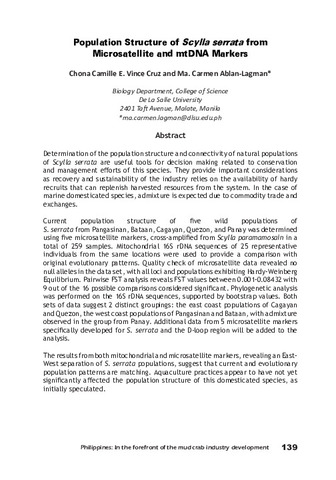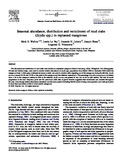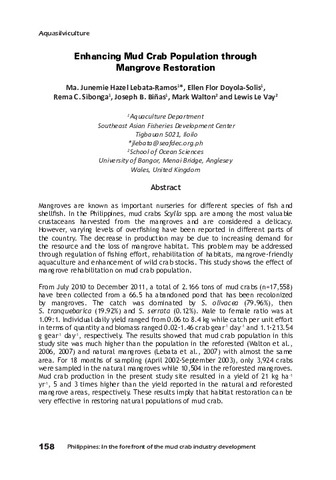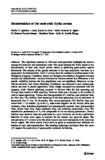Population structure of Scylla serrata from microsatellite and mtDNA markers
Share
Abstract
Determination of the population structure and connectivity of natural populations of Scylla serrata are useful tools for decision making related to conservation and management efforts of this species. They provide important considerations as recovery and sustainability of the industry relies on the availability of hardy recruits that can replenish harvested resources from the system. In the case of marine domesticated species, admixture is expected due to commodity trade and exchanges.
Current population structure of five wild populations of S. serrata from Pangasinan, Bataan, Cagayan, Quezon, and Panay was determined using five microsatellite markers, cross-amplified from Scylla paramamosain in a total of 259 samples. Mitochondrial 16S rDNA sequences of 25 representative individuals from the same locations were used to provide a comparison with original evolutionary patterns. Quality check of microsatellite data revealed no null alleles in the data set, with all loci and populations exhibiting Hardy-Weinberg Equilibrium. Pairwise FST analysis reveals FST values between 0.001-0.08432 with 9 out of the 16 possible comparisons considered significant. Phylogenetic analysis was performed on the 16S rDNA sequences, supported by bootstrap values. Both sets of data suggest 2 distinct groupings: the east coast populations of Cagayan and Quezon, the west coast populations of Pangasinan and Bataan, with admixture observed in the group from Panay. Additional data from 5 microsatellite markers specifically developed for S. serrata and the D-loop region will be added to the analysis.
The results from both mitochondrial and microsatellite markers, revealing an East-West separation of S. serrata populations, suggest that current and evolutionary population patterns are matching. Aquaculture practices appear to have not yet significantly affected the population structure of this domesticated species, as initially speculated.
Description
Abstract only.
Suggested Citation
Vince Cruz, C. C. E., & Ablan-Lagman, M. C. (2017). Population structure of Scylla serrata from microsatellite and mtDNA markers. In E. T. Quinitio, F. D. Parado-Estepa, & R. M. Coloso (Eds.), Philippines : In the forefront of the mud crab industry development : proceedings of the 1st National Mud Crab Congress, 16-18 November 2015, Iloilo City, Philippines (p. 139). Tigbauan, Iloilo, Philippines: Aquaculture Department, Southeast Asian Fisheries Development Center.
Subject
Taxonomic term
Related items
Showing items related by title, author, creator and subject.
-
Seasonal abundance, distribution and recruitment of mud crabs (Scylla spp.) in replanted mangroves
Walton, Mark E.; Le Vay, Lewis; Lebata, Junemie H.; Binas, Joseph; Primavera, Jurgenne (Elsevier, 2006)The abundance and distribution of mud crabs were studied in a replanted mangrove forest in Buswang, Aklan, Philippines. Two fishing gears, lift nets and bamboo traps, were used to monitor relative abundance of Scylla spp. ... -
Enhancing mud crab population through mangrove restoration
Lebata-Ramos, Ma. Junemie Hazel; Doyola-Solis, Ellen Flor; Sibonga, Rema; Biñas, Joseph B.; Walton, Mark; Le Vay, Lewis (Aquaculture Department, Southeast Asian Fisheries Development Center, 2017)Mangroves are known as important nurseries for different species of fish and shellfish. In the Philippines, mud crabs Scylla spp. are among the most valuable crustaceans harvested from the mangroves and are considered a ... -
Domestication of the mud crab Scylla serrata
Quinitio, Emilia T.; de la Cruz, Joana Joy; Eguia, Maria Rowena R.; Parado-Estepa, Fe Dolores; Pates Jr., Gaudioso S.; Lavilla-Pitogo, Celia R. (Springer Verlag, 2011)The significant decrease in wild mud crab population highlights the need to manage the resources and domesticate crabs. This paper presents the initial results of the domestication of mud crab Scylla serrata aimed at ...






